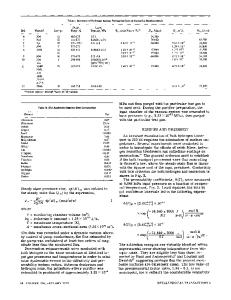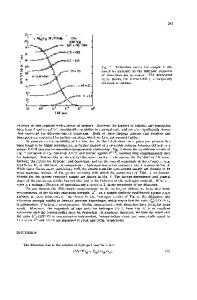Thermotransport of hydrogen and deuterium in vanadium-niobium, vanadium-titanium, and vanadium-chromium alloys
- PDF / 394,650 Bytes
- 4 Pages / 603.28 x 788 pts Page_size
- 73 Downloads / 374 Views
I.
INTRODUCTION
THE movement of solute atoms caused by temperature gradients in solid metals has been a subject of research for many years. At present, an atomistic explanation for thermotransport in metals has not been established. Previous studies of thermotransport have involved a dilute concentration of solute in an otherwise pure metal. Consequently, little is known about thermotransport in more complex alloys. Multicomponent alloys are commonly used in engineering applications, and thermotransport of solutes in such materials may be of practical interest. In addition, changes in the heat of transport which result from alloy additions could provide insight into the nature of thermotransport. In an earlier investigation, the present authors studied thermotransport of hydrogen and deuterium in pure vanadium and niobium. ~This study examines thermotransport of hydrogen and deuterium in vanadium-niobium, vanadium-titanium, and vanadium-chromium alloys. These vanadium alloys are homogeneous solid solutions in the regimes of interest, 2-5 and terminal solubilities for hydrogen in these alloys are quite high. 6-1~A concurrent study by Peterson and Herro 11has shown that diffusivities of hydrogen and deuterium in these alloys are also quite high. Thus, experiments based on steady state techniques could be conducted in single phase metals at moderate temperatures in reasonable times. The selection of alloy elements from three adjacent columns of the periodic chart also provided a variation in the electron/atom ratio which could prove useful in evaluation of mechanisms ~2'13:4 for thermotransport. In addition, hydrogen and deuterium allowed isotope effects in thermotransport to be observed. II.
EXPERIMENTAL PROCEDURE
The heat of transport, Q*, is a phenomenological parameter which describes thermotransport. In this study, values of D.T. PETERSON is Professor, Department of Materials Science and Engineering, Iowa State University, and is Senior Metallurgist, Ames Laboratory-USDOE, Ames, IA 50011. M. E SMITH, formerly Graduate Student, Department of Materials Science and Engineering, Iowa State University, is now with Sandia Laboratories, Albuquerque, NM 87115. Manuscript submitted February 9, 1982. METALLURGICALTRANSACTIONSA
Q* were determined by a steady state technique described in an earlier publication. ~Therefore, only a brief description of the experimental method is presented here. Each specimen was electrolytically charged with approximately equal molar amounts of both hydrogen and deuterium to a total concentration of 0.01 (H + D)/M, where M represents the host metal alloy. A 1.0 cm length at one end of each 2.5 • 1.0 • 0.08 cm specimen was inserted into a heat source, and an equal length at the opposite end was clamped into a heat sink. This arrangement produced a 200 ~ isothermal region at one end of the specimen, 150 ~ isothermal region at the other end, and a temperature gradient in the portion between. Temperatures in the isothermal regions were monitored with calibrated chromel-alumel thermocouples. A
Data Loading...











